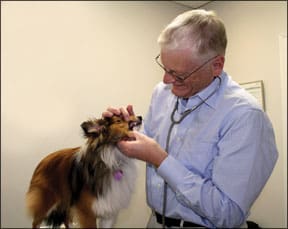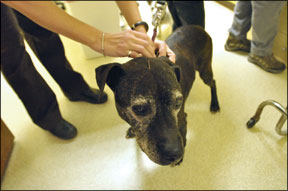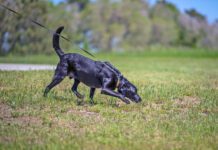As your pet’s human companion, you want to do the best you can for him or her, as do the clients who come to my clinic. In my opinion, a holistic approach will give you new tools to ensure that your pet stays as happy and well as possible. I would like all animal caretakers to learn a new perspective on health and healing – one that respects the best that natural health care and mainstream medicine have to offer, yet goes beyond the limitations of both. This new way of thinking will take you beyond fixing immediate problems and will give you a fresh and comprehensive take on prevention.

Photo by Jeanette Johnstone
The holistic way of thinking also involves seeing your role and your veterinarian’s role in a different way. Because you are the person closest to your dog, you are in the best position to influence her well-being. You have the primary responsibility for making decisions that affect her quality of life. In my view, a veterinarian is a coach who provides expert opinions, perspectives, and advice about how to support your pet’s wellness. At times, he may point you toward further resources and even toward other types of health care professionals to help you do that.
The holistic way of thinking that is so important to your pet’s wellness begins with the way we look at health.
Holistic health care: more than a set of treatments
Mainstream medicine has significantly influenced how people in the West think about health and healing. But since the 1970s, natural health care methods have steadily gained acceptance as effective, safe, and life-affirming ways to support the wellness of both humans and pets. These natural approaches are often referred to as holistic. In fact, the word holistic has picked up so much cultural momentum that it’s used to sell products and services ranging from pet foods, shampoos, and beds to Sophie’s weekly swim at the neighborhood dog spa. This encouraging sign shows that people want to do the best they can for their pets and the environment. But do all the claims that these products and services are holistic bear out?
For example, even the best foodstuffs can’t be holistic (let alone natural) if most of the life has been cooked, dried, sanitized, and packaged out of them. Neither can a so-called herbal pet shampoo or grooming aid be completely wholesome and safe if it also contains industrial chemicals known to be harmful for a pet. When it comes to health care, many people believe that a practice is holistic if it uses homeopathy, acupuncture, nutraceuticals, chiropractic, massage, or other natural therapies. But my clinical experience has taught me that no therapeutic remedy, supplement, or system is holistic in itself. The holistic way cannot be defined by its remedies alone. In fact, any therapy can serve either the goals of the holistic way or those of mainstream medicine. And those goals are very different.
What is the new holistic way?
Based on more than four decades of veterinary practice, I want to take holistic health care into new territory. This is why I call my approach the new holistic way. I don’t claim that all the ideas in this book are new. You will find many of them familiar if you already use modalities that are not part of mainstream medicine. Others have worked hard to promote these approaches, and I acknowledge that I am building on their excellent work. However, in my view many of these methods and concepts remain locked in and shaped by the historical contexts out of which they arose, as does mainstream medicine itself. Although they undoubtedly served well their original times, places, and cultures, today they are thrown together in a new context. As many different approaches to health care intermingle in this context, including traditional, indigenous, energy based, and recent developments in Western science, I see a synergy emerging.
To unleash this synergy, I offer a way of thinking that links the many different approaches to health care with our growing knowledge of how stress affects well-being. This is why I emphasized earlier that the new holistic way is not defined by its remedies alone. Instead, it guides us in choosing and applying whatever therapies or combination of therapies will work to address the health challenges that dogs and cats experience in contemporary life.
This new way of thinking is based on the premise that every expression of health – from wellness to unwellness to illness – emerges from the interaction of two factors. The first factor is the living terrain, which is the body itself, and the second is stress. I am convinced that better pet care will result when pet lovers and veterinarians understand that stress is the underlying cause of every form of health problem a dog or a cat can have.
In modern life, stress challenges the living terrain in infinite ways. Stress and the living terrain take part in a dynamic, never-ending dance from which all health outcomes flow.
By focusing on the relationship between a dog’s stress and the living terrain, the new holistic way strives to achieve the following goals:
1. Support the health of the living terrain.
2. Free up blocked energy.
3. Consider the whole individual.
4. Look for the hidden stress factor that’s causing the problem.
The living terrain: the foundation of wellness
When a client brings a pet into my clinic, my aim is to help that animal thrive the way she is meant to. Nothing delights me more than seeing a dog become radiant with enthusiasm for life, with shining eyes, glistening fur, a great appetite, and legs that move effortlessly with synchronicity and grace. My satisfaction as a veterinarian comes from helping my patients go from whatever condition they started with toward the highest degree of wellness they can attain.
The new holistic way begins and ends with supporting the condition of our pets’ bodies – the living terrain.
In holistic thinking, wellness springs from the living terrain. Densely packed and highly complex, the living terrain consists of tissues that are made up of billions of living cells. The cells organize together to form organs, hormones, the nervous system – every part of the body – and from these, all the body’s functions arise. Zooming in even closer for a moment, we can see that every cell is made up of molecules. Molecules are tiny bundles of energy – and energy is a superstar in the holistic view of life. We’ll come back to the great importance of energy in a moment.
The living terrain is dynamic and alive. That’s why I call it the living terrain. It has an integrity – an intelligence, we might say – of its own. It reaches for life just as a flower or tree reaches toward the sun. It constantly affects the environment of which it is a part, and the environment affects it in turn. All of us as individuals – whether canine, feline, or human – express ourselves through, and are one with, our own living terrain.
In a marvelously orchestrated and brilliant way, all aspects of a dog or cat’s living terrain – his molecules, cells, tissues, organs, and systems – communicate and cooperate with each other to allow him to express himself according to his nature as a living being. We refer to this communication and cooperation between all aspects of the living terrain as synergy. To support the health of the living terrain, the new holistic way focuses on all of these dimensions: the molecules, cells, tissues, organs, and systems; the synergistic communication among them; and the energy that manifests and powers them.
Nourishing and supporting our pets’ living terrains appropriately in everyday life is the single most important thing we can do for their wellness. Festus and Samson’s health needs don’t end the moment they leave my clinic. The new holistic way’s number one priority is to keep the living terrain, including the immune system, as well as possible all the time. If Festus and Samson are bursting with wellness when they walk out the door to go home, they won’t sustain that condition unless their people look after them in ways that allow their immune systems to remain strong. I consider it part of my job as a veterinarian to coach my clients about how to do that.
The vital importance of free-flowing energy
The health of the immune system, like that of the rest of the living terrain, depends upon how well living energy flows through it. In the new holistic way, all paths lead back to the fundamental importance of energy.
I first became aware of the role of energy flow to the living terrain’s remarkable power to heal itself when I tried to help a German Shepherd Dog who had a bad leg wound that would not mend. Before I saw him, the dog had been taken to other clinics and been put through the gamut of mainstream therapies, including many different antibiotics. One dedicated vet even tried to surgically reestablish normal tissue in the area, after which the wound partially healed, but then it broke down and reopened again. When I saw it, it had formed a weeping, seeping, fistulous tract. There was no foreign object in it, no infection, no known reason why it wouldn’t heal. But it would not.
Because I wanted to try stimulating the body’s own ability to heal rather than using methods that acted directly upon the wound, I gave the Shepherd an arbitrary dose of homeopathic Silicea tissue salts. Over a short period of time the wound healed up completely. I was thrilled to see a safe, subtle, natural substance such as this work so effectively.

I realized that the wound had not healed previously because the dog had an energy block that affected the area. Neither antibiotics nor surgery had done the trick; the fistula did not resolve until we used a therapy that removed the block on the subtle energy field. If we hadn’t moved out the block, the healing would not have happened. Somehow, the homeopathic tissue salt enabled the healing process by releasing the block so that energy was able to flow freely again.
Everything is made of energy, and energy powers everything. Nearly every ancient or traditional healing system has recognized this. Each tradition has its own understanding of where energy comes from and what it means. Whether they use the words chakras, chi, life force, spirit, or electrons, people are talking about energy. Whatever we may call it, free-flowing energy and the crucial role it plays are front and center in the new holistic approach to health care.
Looking through the lens of our Western mind-set, we have been slow to accept energy as a factor in health care. We think that if we can’t see it, it isn’t really there. Yet we accept other powerful forces that we can’t see. For example, when was the last time you saw the wind? But we see and feel its tremendous effects as it bends trees, flaps the laundry on the line, pushes clouds around, or buffets the cars we ride in. It’s the same with gravity. We don’t see it, but we feel it and know it’s really there. It’s the reason we have to be careful climbing stairs and must hold pets or babies securely in our arms. As we age, we experience its effect on our bodies. Like the wind and gravity, the energy that moves us and forms our bodies really exists. We can’t address our health needs if we ignore it or fail to acknowledge it.
Nothing happens without energy. The appliances that make a modern home comfortable depend upon its free and proper flow. When too little electricity flows, appliances slow down and grind to a halt. If too much electricity surges through them or flows in the wrong way, they short-circuit and malfunction or burn out altogether.
Like the electricity that flows through a house, the energy that flows through living beings keeps vital systems functioning at their best. An animal’s health and well-being depend upon her life energy being able to flow as it’s meant to. When her energy doesn’t move well, physical problems begin to develop at the cellular level and interfere with the functions of tissues, organs, glands, and other crucial aspects of the body – as happened with the German Shepherd whose wound would not heal. This is why holistic health care focuses on freeing up any blocked energy within a pet’s living terrain.
In dogs, cats, and people, energy expresses itself not only physically but also emotionally and mentally. (The mental aspect is especially developed in humans.) Emotional and mental states affect the living terrain of our bodies, and the terrain, in turn, influences how we feel and think. Again, we see the wonderful synergy that manifests in each living being. When energy flows as it’s meant to, our pets experience the balance of homeostasis. They feel the pleasure of life and the joy of good health. But when something blocks the physical or emotional energy that should flow through their living terrain, their wellness deteriorates. Then, signs and symptoms show up to tell us something is wrong.
But signs and symptoms manifest differently in every individual dog, cat, or human. This brings us to the next goal of the holistic way.
Taking individuality into account
Because signs and symptoms present themselves differently in everyone, the holistic way regards each patient as an individual who has a unique response to stressors that may challenge her living terrain.
Sometimes two individuals will have the same illness and will display it in different ways. Other times, they will have different illnesses but show exactly the same symptoms. I had a chance to see this for myself when two dogs, both previously diagnosed with Cushing’s disease, were brought to my clinic within a few weeks of each other.
The first case was that of a Wire Fox Terrier called Casey who had typical signs of Cushing’s and lab results that backed up the diagnosis. Cushing’s disease involves overactivity of the adrenal gland and is often associated with a brain tumor affecting the pituitary gland. It typically reveals itself through excessive eating, drinking, fluid retention, and urination, and the patient becomes weak and lethargic. Because veterinarians don’t yet know how to cure it, we try to control the condition and make the patient more comfortable for the time she has left. This is usually done using invasive pharmaceutical drugs that can have severe side effects.
Casey’s people brought him to me because they’d been told that he had to be put on a drug that would have damaged his adrenal glands, and they didn’t want to go that route. But there is another drug, used for treating Parkinson’s disease in people, that will sometimes control Cushing’s cases. I was hopeful it would work for Casey so we could avoid the other options. To the relief of my clients and me, it did work. With the help of the less risky pharmaceutical we were able to keep Casey going for a couple more years until he passed away.
The second case involved Rosie, an Airedale who had the same symptoms as Casey. Even the lab reports of the two dogs matched. Rosie’s people were aware of the standard Cushing’s drugs and didn’t want to risk her suffering their side effects, so before they agreed to use them they came to me, hoping for an alternative.
My first inclination was to approach Rosie’s case the same way I had approached Casey’s case. But as her people and I discussed her history, important information emerged. This dog was living under tremendous emotional stress. Josie and Rob were working out a marital separation, and they shared custody of Rosie by shifting her back and forth between them.
As we talked, we realized that her symptoms became much worse when she stayed with Rob and eased off when she stayed with Josie. Something didn’t add up – a dog would not have classic Cushing’s disease in one environment but not in another. So, given Rosie’s circumstances, I decided to try a different tack: we could experiment to see whether we could improve the dog’s condition by reducing her environmental stress. At the same time, we would aid her living terrain with gentle, supportive remedies.
Josie and Rob agreed to try letting Rosie stay full time with Josie. I supplied them with raw adrenal supplements combined with appropriate herbs, as well as homeopathic and flower remedies. Once all these changes were in place, Rosie’s symptoms completely disappeared.
I was delighted that we were able to solve such a challenging problem by modifying the environment instead of using powerful drugs. And it was evident that although Rosie’s symptoms mimicked Casey’s, she didn’t have Cushing’s at all. Instead, her adrenal glands were under stress induced by an emotional situation. If I’d looked solely at the similar signs and symptoms of the two cases, I would have treated them the same way and unnecessarily subjected Rosie to invasive drugs. The individual characteristics of these two dogs and their underlying circumstances made all the difference in the world.
When a pet’s health deteriorates, the new holistic way guides us to focus on the aspects of her specific case. We consider her genetic background; her physical, environmental, social, and emotional history and present circumstances; and her particular signs or symptoms. Such information provides clues about the underlying cause of the patient’s stress, as it did with Rosie. It also helps us gauge how her immune system has responded to the problem.
Managing a Dog’s Stress
I am convinced that better pet care will result when pet lovers and veterinarians understand that stress is the underlying cause of every form of health problem a dog or a cat can have.
In modern life, stress challenges the living terrain in infinite ways. Stress and the living terrain take part in a dynamic, never-ending dance from which all health outcomes flow.
Acute stress is immediate and intense. It can be caused by an accident, a sudden infection, or a powerful toxin. Although it’s usually short-lived, if it’s too much for our pets to handle, it can have very serious consequences. But if a pet is healthy, she will overcome most acute stressors. You can help your pet by preventing acute stress in whatever ways you are able and by supporting her living terrain so that if a challenge confronts her, she can successfully hold her own.
Chronic stress, on the other hand, can be a real drag on wellness. Often, when a dog or cat with a serious illness such as cancer is brought to my clinic, I will discover that she has been suffering from chronic stress due to a long-standing cause that had been neither identified nor addressed.
Once a stressor is recognized and modified and the living terrain given support, a pet will improve either emotionally or physically or both, and at least some future problems will be prevented. But because of the toll chronic stress takes on the living terrain, many of these pets will need ongoing support to maintain their best level of wellness. It’s worth the effort – it’s wonderful to see a pet who has suffered from chronic stress become both happier and healthier.
Because it is prolonged and persistent, chronic stress can wear down a pet over time. Its effects manifest differently in each individual. One animal may show it through a behavioral issue; another, through a gastrointestinal disturbance; and a third, through unexplained weight loss. It may also produce problems with organs or glands, such as heart disease or diabetes. Chronic stress tends to need ongoing support, but the right approach will ease, and sometimes even resolve, the health care issues it may cause.
Chronic stress can also compromise a pet’s health indirectly. For example, she may become more susceptible to infections, and eventually to degenerative conditions such as cancer or allergies. These conditions often vary in intensity. For instance, allergies tend to come and go depending on the season or the availability of irritants; arthritis is affected by damp weather or too much or too little exercise, and cancerous growths don’t always grow at a steady rate and sometimes actually get smaller. Although appropriate health care will improve most of these problems, they can be very challenging to address. All of them depend on the strength of the other major factor that plays a starring role in maintaining our pets’ health: the immune system.
Overall, both the stress response system and the immune system depend on an abundant supply of energy, which, in turn, they burn up as they carry out their functions in keeping our pets alive. Each system does best if the body’s living terrain is in good shape to begin with, and they don’t do so well if it isn’t. Negative stress, whether chronic or acute, makes both the stress response system and the immune system less effective in protecting our dogs and cats. On the other hand, recent research has shown that reducing negative stress has the effect of boosting the immune response. In sum, reducing stress not only eliminates the cause of a dog or cat’s unwellness or illness, but also, through boosting the immune system, it improves her state of wellness.
Whether stress is physical, emotional, or mental in origin, it affects every aspect of our pets’ health. We’ve seen that positive stress boosts the immune system and general wellness, while negative stress depletes energy, damages tissues, and pushes the body until it is unable to eliminate cellular by-products that can damage it. Too much negative stress can make a cat or dog vulnerable to viruses, bacteria, toxins, or parasites; weaken organs and vital systems; or turn her body against itself through autoimmune disease or cancer. Stress can cause an almost infinite range of trouble for a pet and only a health care perspective that’s broad, inclusive, and flexible can address the possibilities. By taking a holistic approach and learning how to manage our pets’ stress, we can make an enormous difference to their well-being and happiness.
The health care of the future
Clearly, whether we support our pets’ health care holistically depends not so much on which modalities we choose – or whether we buy natural products, for that matter – but on why and how we use them and what we hope to achieve with them. And while both natural and mainstream medical tools have a place in holistic practice, the mainstream way of thinking about health leads to a very limited approach to health care. By thinking holistically, we can assess situations more broadly, choose tools more wisely, and have greater success in restoring homeostasis. In my experience, only the holistic way can fully support an animal’s optimal wellness.
Knowing the difference between the mainstream approach and the new holistic way provides you with a valuable tool for making crucial decisions about the care of your dog.






